The Rockwell B-1 Lancer, widely recognized as the B-1 worldwide and referred to as the ‘Bone’ by USAF personnel due to its ‘B-One’ designation, stands as one of the cornerstones of America’s long-range bomber fleet. The article is Unveiling the Best Details of the B-1 Lancer Bomber which also constitutes the backbone of the nation’s long-range bomber capabilities and has the ability to deliver a substantial payload of both precision and non-precision weaponry, along with achieving supersonic speeds of Mach 1.25, the B-1 bomber excels at promptly engaging potential adversaries across the globe on short notice—a capability lacking in the other American bombers as of 2023.
It is operated by the United States Air Force (USAF) and serves as a crucial component of the U.S. military’s long-range strike capabilities and exhibits exceptional manoeuvrability across diverse flight conditions. It was initially designed as a nuclear weapon delivery system to meet the 1965 need for a fast, low-level B-52 Stratofortress replacement.
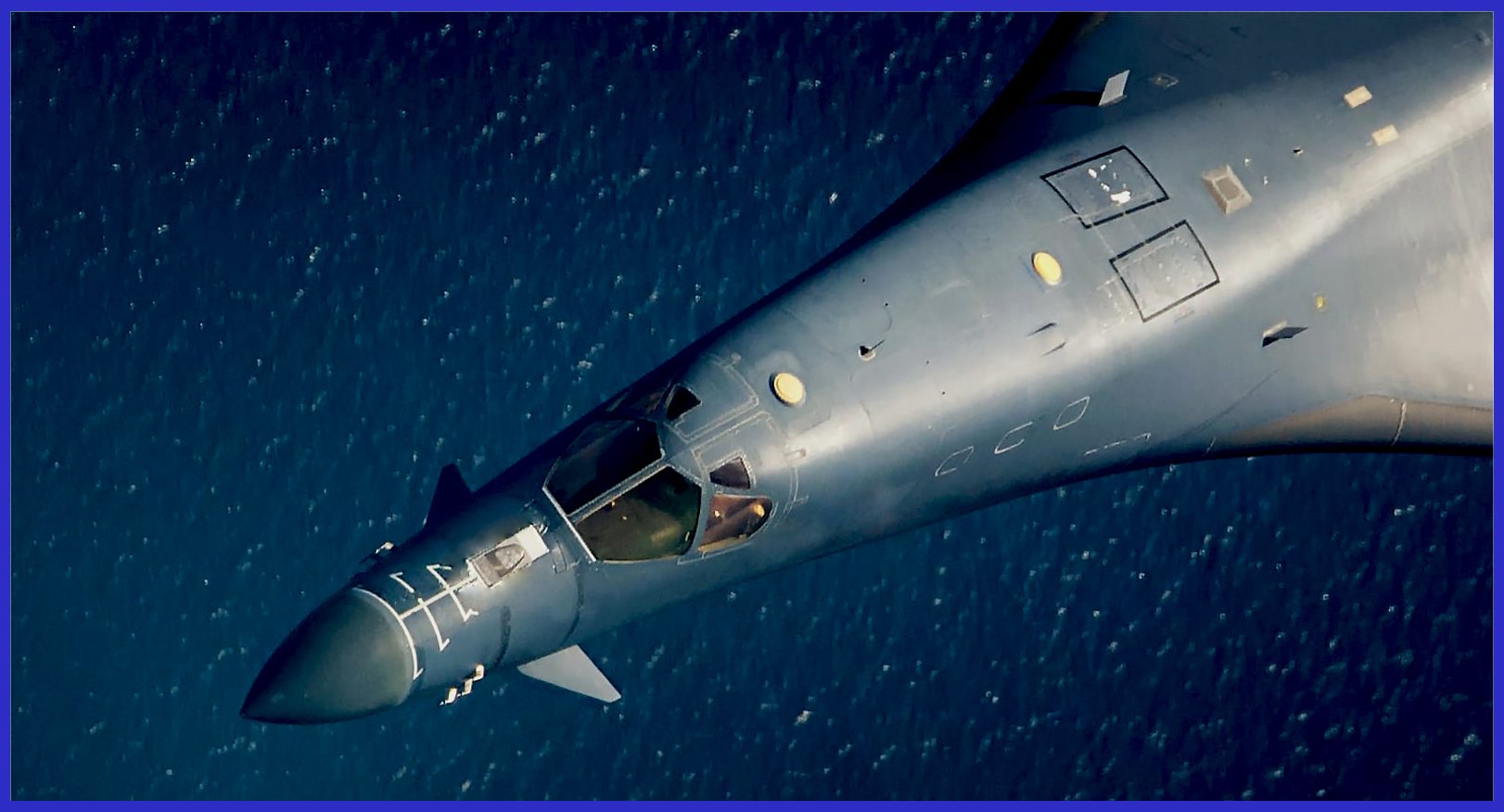
After a comprehensive series of research endeavours, the construction phase of the inaugural B-1A prototype was initiated in the latter part of 1972. Subsequently, on December 23, 1974, the prototype accomplished its maiden flight. This specific iteration achieved a peak velocity of Mach 2.2 during high-altitude flights, supplemented by the capability to efficiently traverse extended distances at Mach 0.85 when flying at significantly lower altitudes. As of the conclusion of June 1977, a trio of prototypes had concluded a total of 118 flight missions, amassing a cumulative flight duration of 646 hours. Escalating expenditures prompted the termination of the project in 1977.
However, intriguingly, trials of the B1-As endured until 1981, serving as an interim solution primarily due to setbacks in the development of the B-2 stealth bomber initiative. Consequently, modifications were made to the B-1A design, resulting in a reduction of its maximum speed to Mach 1.25 for high-altitude operations. Simultaneously, enhancements were implemented to elevate the low-altitude speed to Mach 0.96, extensively refine electronic components, and augment the airframe’s capacity for enhanced fuel and armament carriage.

The bomber was brought back to use by the Reagan government in 1982 after a lot of important military and political support. They made an improved version, called the B1-B, which started flying on October 18, 1984. This new version was different from the earlier B1-A because it had better equipment, a stronger base, seats that could shoot the pilots out in emergencies, and the ability to carry weapons outside the plane.
The first B1-B was given to Dyess Air Force Base in Texas in June 1985. It officially joined the Strategic Air Command (SAC) as a nuclear bomber the next year. It was fully ready for action on October 1, 1986. The last out of the 100 B1-B planes was handed over on May 2, 1988. Each plane cost 200 million US dollars. This was a really fast rate of making planes, especially when compared to how planes are made today.

The Concept Behind the Development of the B-1 Lancer: Supersonic Bomber
In 1955, the United States Air Force (USAF) established criteria for a novel bomber that could integrate the payload and range capabilities of the Boeing B-52 Stratofortress. Additionally, there was a specific emphasis on achieving supersonic speeds, with a targeted maximum velocity of Mach 2. This objective closely mirrored the characteristics of the Convair B-58 Hustler, the aircraft that the new conceptual bomber was intended to succeed in. Here’s an overview of its development history:
Origins and Cancelation of B-70 Valkyrie: The development idea of the B-1 Lancer can be traced back to the 1950s when the United States Air Force (USAF) was engaged in the development of the B-70 Valkyrie, a high-speed, high-altitude strategic bomber. In December 1957, the USAF opted for North American Aviation’s B-70 Valkyrie for this purpose. This six-engine bomber was capable of cruising at Mach 3 at a high altitude of 70,000 ft. However, due to escalating costs, advancements in Russian surface-to-air missile technology, and a growing shift towards the intercontinental ballistic missile (ICBM) force, President John F. Kennedy ultimately cancelled the B-70 bomber program in 1961.

Emergence of the B-1 Concept: As a replacement for the B-70, the USAF sought a new bomber capable of carrying out both strategic and conventional missions. The concept of the B-1 began to take shape as a long-range, variable-sweep wing bomber with supersonic capabilities, with the intent to create an aircraft that could penetrate enemy defences while carrying a substantial payload. This concept was initially met with opposition by the previous Secretary of Defense, Robert McNamara, who preferred ICBMs over bombers for the Air Force’s deterrent force and believed that a new expensive bomber was unnecessary.
However, in 1969, President Richard Nixon reestablished the AMSA (Advanced Manned Strategic Aircraft) program after taking office. This move was in line with his administration’s flexible response strategy, which aimed to maintain a wide range of options below the threshold of general nuclear war. In April 1969, the program was officially designated as the B-1A. Subsequently, the Air Force issued a request for proposals in November 1969, which garnered submissions from Boeing, General Dynamics, and North American Rockwell in January 1970. Finally, in June 1970, North American Rockwell’s design for the bomber was awarded the development contract.
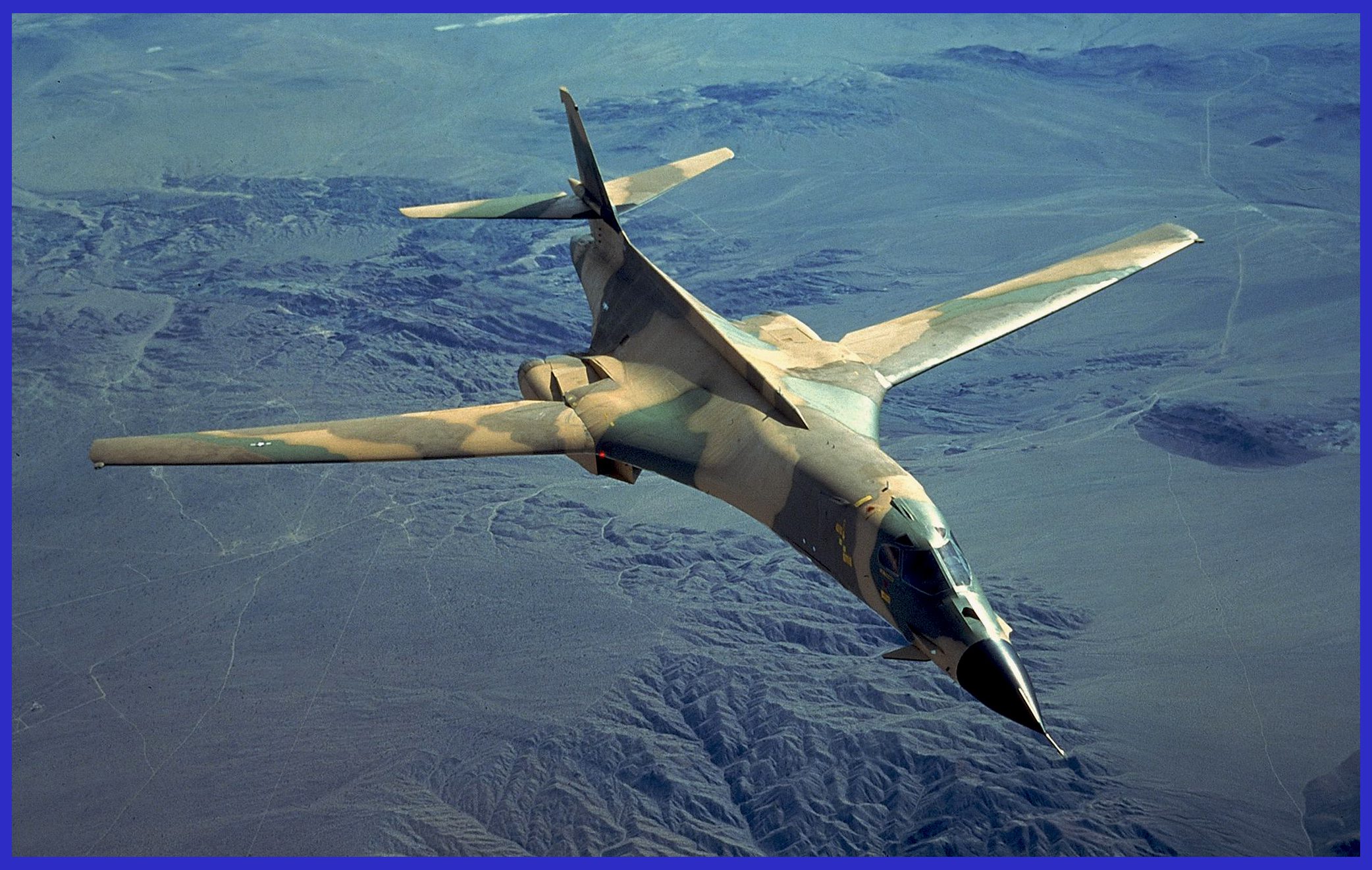
Rockwell B-1 Development and Testing: Rockwell International, which is now part of Boeing, was awarded the contract to develop the B-1A bomber. The initial design put a strong emphasis on incorporating a variable-sweep wing to enable both high-speed flight and low-speed manoeuvrability. The development process was notable for its array of technical challenges, foremost among them being the task of designing a wing capable of seamlessly adjusting sweep angles while upholding structural integrity.
During the early stage of the design, the first three B-1As were outfitted with a crew escape capsule that functioned as a unit. This innovative feature was intended to significantly enhance crew survivability in situations necessitating rapid aircraft abandonment at high speeds. In order to attain the requisite Mach 2 performance at high altitudes, engineers integrated variable exhaust nozzles and air intake ramps into the design. Initially, there was an anticipation that the aircraft could achieve a Mach 1.2 performance level at low altitudes, which, in turn, necessitated the strategic use of titanium in critical areas of both the fuselage and wing structure.
However, a subsequent decision led to the revision of the requirement for low altitude performance, ultimately lowering it to a subsonic speed of Mach 0.85. This adjustment not only led to a reduction in the required amount of titanium but also brought about cost savings. A notable addition to the aircraft’s design includes a pair of small vanes (canards) strategically positioned near the nose, serving as an integral component of an active vibration-damping system. This sophisticated system effectively mitigates the otherwise turbulent nature of low-altitude flight.
Interestingly, a redesign was undertaken for the cockpit of the fourth B-1A prototype. This redesign involved equipping each crew member with a conventional ejection seat, marking a departure from the previous configuration.

Carter Administration and Program Cancellation: During the 1970s, the B-1 program encountered substantial scrutiny. Nevertheless, the initial cancellation of the program by the Carter administration in 1977 was unfortunate, driven by concerns over cost-effectiveness and shifting strategic priorities. This choice sparked discussions regarding the necessity of introducing a new stealth bomber, the B-2 Spirit, as well as the role to be played by the Air-Launched Cruise Missile (ALCM). Notably, Pentagon officials asserted that utilizing the ALCM from the existing B-52 fleet would provide the United States Air Force (USAF) with comparable capability for penetrating Soviet airspace.
The ALCM’s range of 1,500 miles (2,400 km) enabled launches well beyond the reach of Soviet defences, allowing it to infiltrate at a low altitude akin to a bomber. This characteristic, combined with its smaller size resulting in a significantly reduced radar cross-section (RCS), made it feasible to deploy the missile in considerably larger quantities at a lower cost. The potential for a handful of B-52s to unleash numerous ALCMs would effectively overwhelm the defence system. In terms of expenditure, enhancing the B-52, coupled with the development and deployment of the ALCM, was projected to be at least 20% more economical than the intended 244 B-1As.
Notably, the Soviets exhibited heightened concern about the substantial quantity of ALCMs, which posed a significantly graver threat compared to a limited number of B-1s. This anxiety was echoed by the Soviet news agency TASS, which commented on the consequential escalation of the strategic arms race due to these military plans. Interestingly, the Soviets were concurrently pursuing the creation of similar swept-wing bomber types, exemplified by the enduring presence of the Tupolev Tu-22M3 and Tu-160 Bombers.
In this context, the flight testing phase for the B-1A program persisted until April 1981. The comprehensive program encompassed 70 flights, accumulating a total duration of 378 hours. Impressively, the second B-1A prototype achieved a remarkable top speed of Mach 2.22. Concurrently, the testing of engines, specifically the YF101 engines, continued and accrued an impressive aggregate runtime of almost 7,600 hours.

Rebirth under the Reagan Administration: The B-1 program was revived during the Reagan administration, which recognized the necessity of a modern bomber to fortify U.S. defence capabilities. This led to the development of the modified B-1B variant, featuring enhancements in survivability, range, and payload capacity compared to the original design. The primary objective of the B-1B was to complement the existing B-52 fleet, albeit in smaller numbers but with heightened quality of support.
The underlying rationale for this revival stemmed from developments after 1985, particularly the Soviet deployment of the S-300 SAM system, the MiG-31 interceptor, and the initial operationalization of effective Soviet Airborne Early Warning and Control (AWACS) systems. These advancements exacerbated the B-52’s vulnerabilities. In 1981, government funding was allocated to initiate a new study for a bomber capable of meeting the demands of the 1990s. This effort gave rise to the Long-Range Combat Aircraft (LRCA) project, which assessed the feasibility of the B-1, F-111, and the Advanced Technology Bomber (ATB) as potential solutions. While multi-role capabilities were emphasized, this direction clashed with the strategic focus necessitated by escalating tensions with the Soviets.
By 1981, it was anticipated that the B-1 could become operational before the ATB, bridging the gap between the B-52’s growing vulnerability and the introduction of the ATB. Consequently, the Reagan administration decided that acquiring both the B-1 and ATB was the most prudent strategy. In October 1981, Reagan announced the order of 100 B-1s to fulfil the LRCA role. The following year, the U.S. Air Force awarded two contracts to Rockwell, collectively valued at $2.2 billion, to oversee the development and production of 100 new B-1 bombers. Notably, substantial alterations were introduced to the design to align it with the expected mission profiles, leading to the inception of the B-1B.
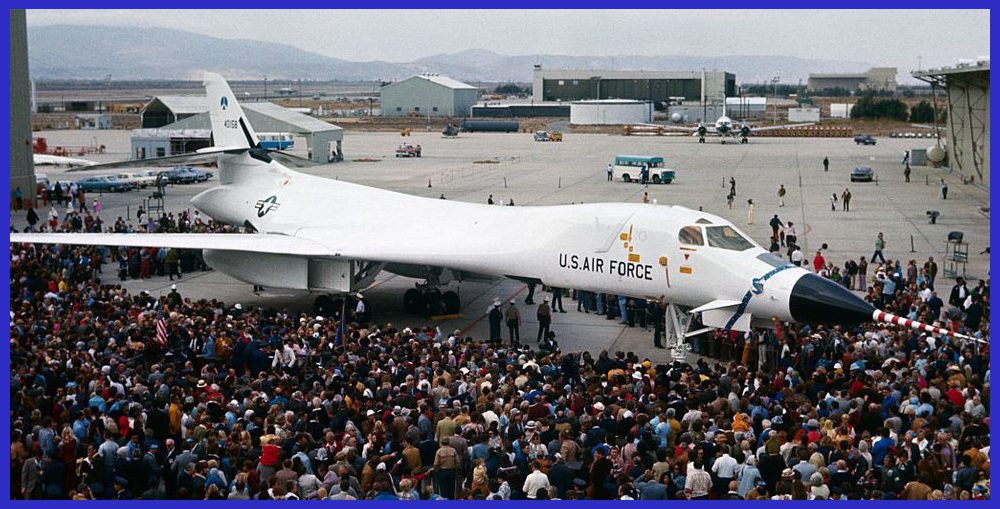
These design adjustments encompassed a reduction in maximum speed, enabling the replacement of variable-aspect intake ramps with simpler fixed-geometry intake ramps. This alteration diminished the B-1B’s radar cross-section, deemed a favourable trade-off for the speed reduction. Moreover, the revised design concentrated on achieving high subsonic speeds at low altitudes. To counter the challenges posed by the Soviet MiG-31 equipped with the new Zaslon radar system and other aircraft boasting look-down capabilities, the B-1B’s electronic warfare suite underwent significant enhancement.
The inaugural production B-1B was unveiled on September 4, 1984, and its maiden flight occurred on October 18, 1984. The final B-1B, the 100th one, was delivered on May 2, 1988. However, ongoing internal upgrades are an integral facet of any weapon system until its eventual retirement.
Adaptations and Upgrades: Over the years, the B-1B underwent various upgrades to enhance its capabilities. These included improvements in avionics, communication systems, radar, and the integration of precision-guided munitions. The B-1B’s versatility was demonstrated in conflicts like the Gulf War, the Kosovo War, the Iraq War, and more recently, in the fight against ISIS.
Continued Service and Future Prospects: Despite occasional discussions regarding the retirement of the B-1B fleet, the aircraft continues to be a crucial asset for the USAF owing to its capacity to execute a range of missions. The Northrop Grumman B-21 Raider is set to gradually supplant the B-1B once it commences service with the USAF. Until that transition occurs, the entirety of the B-1 fleet is scheduled for retirement by 2036.
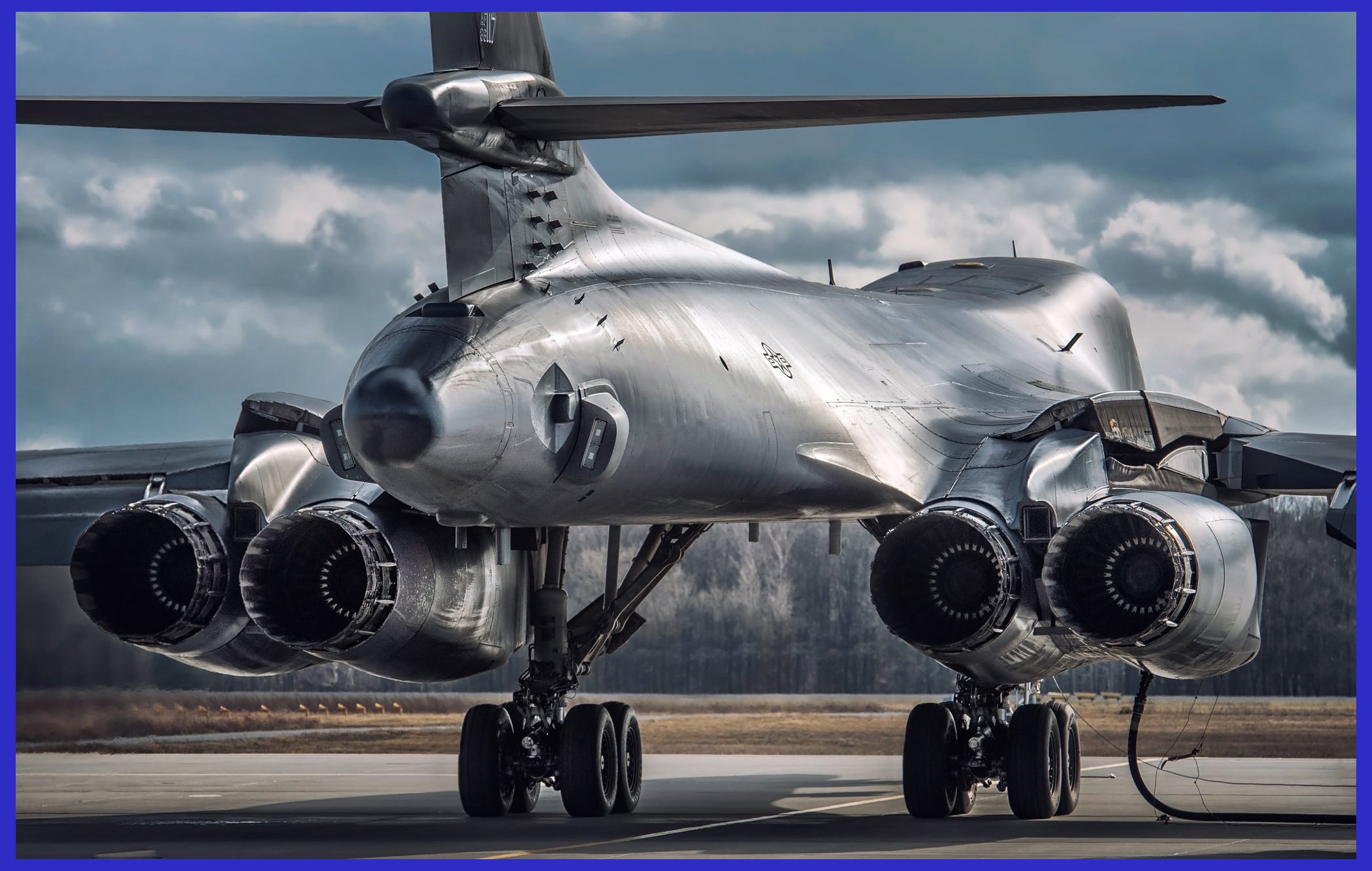
Design Analysis of the Rockwell B-1 Lancer
The Rockwell B-1 Lancer’s design is a result of its intended role as a versatile strategic bomber capable of both high-speed penetration and loitering over target areas. Its design features were carefully engineered to balance speed, range, payload capacity, and survivability.
B1-B’s key design elements:
- Variable-Sweep Wing: One of the most distinctive features of the B-1 Lancer is its blended wing body configuration, which includes a variable-sweep wing. This design enables the wings to pivot at different angles, allowing the aircraft to optimize its performance for various flight regimes. When the wings are swept back, the B-1 can attain higher speeds for supersonic flight, enhancing its capability to penetrate enemy defences. Conversely, when the wings are fully extended, the aircraft gains improved lift and stability for subsonic flight and loitering.
- Sleek Aerodynamics: The B-1’s aerodynamic design minimizes drag and boosts efficiency. Its sleek shape, coupled with retractable features and smooth contours, enables high-speed, high-altitude operations. The wings can sweep from 15 to 67.5 degrees, enhancing takeoff with a favourable thrust-to-weight ratio and shorter runway needs. However, the aircraft’s length faced flexing issues due to low-altitude turbulence. To address this, Rockwell integrated small triangular fin control surfaces near the B-1’s nose.
- Four Afterburning Turbofan Engines: The B-1 is propelled by four General Electric F101-GE-102 turbofan engines. These engines are outfitted with afterburners, delivering an extra thrust surge for high-speed flight. The engines empower the B-1 to attain supersonic speeds and provide the essential thrust for both combat and strategic operations. In contrast to the B-1A, the B-1B is incapable of achieving speeds beyond Mach 2; its maximum speed caps at Mach 1.25. However, its low-level speed has been elevated to Mach 0.92. To diminish its radar cross-section (RCS), the B-1B employs serpentine air intake ducts (known as the S-duct) and fixed intake ramps. Nonetheless, these design features limit its speed in comparison to the B-1A.

- Weapon Bays: The B-1’s internal weapon bays are designed to house a variety of munitions, including bombs and missiles. This internal carriage enhances the aircraft’s aerodynamic efficiency by reducing drag, while also contributing to its stealthiness by minimizing its radar cross-section when loaded with weapons.
- Payload Capacity: The B-1 boasts a significant payload capacity, facilitating the carriage of a wide range of ordnance, spanning from conventional bombs to precision-guided munitions and standoff missiles. It is equipped with six external hardpoints for ordnance (although often underutilized due to radar cross-section concerns) and three internal weapon bays capable of holding up to 75,000 pounds (34,000 kg). This adaptability empowers the aircraft to flexibly address diverse mission needs and engage a variety of target types.
- Advanced Avionics and Sensors: The B-1 is equipped with an array of advanced avionics, encompassing radar systems, electronic warfare suites, navigation systems, and communication equipment. These technologies empower the aircraft to operate adeptly in both contested and controlled environments, detect threats, and navigate with precision. The B-1’s principal computer is the IBM AP-101, a system shared with the Space Shuttle orbiter and the B-52 bomber. This computer is programmed using the JOVIAL programming language.
- The offensive avionics of the Lancer feature the Northrop Grumman AN/APQ-164 forward-looking offensive passive electronically scanned array radar set, employing electronic beam steering. Additionally, there’s a fixed antenna pointed downward to minimize radar observability. This radar set offers capabilities such as synthetic aperture radar, ground-moving target indication (GMTI), terrain-following radar modes, Doppler navigation, radar altimeter, and an inertial navigation suite. Furthermore, the B-1B Block D upgrade, initiated in 1995, introduced a Global Positioning System (GPS) receiver.
- For defence, the B-1 features Eaton AN/ALQ-161A radar warning and jamming gear, with antennas on the wing bases and tail radome. These link to eight flare dispensers atop the canopy, managed by the AN/ASQ-184 system, holding 12 flares each. It’s also prepared for the ALE-50 towed decoy system.

- Survivability Enhancements: The B-1’s design integrates features aimed at boosting its survivability, encompassing advanced electronic countermeasures, defensive systems, and mechanisms to decrease its vulnerability to enemy radar and missile threats. These measures enhance the aircraft’s capability to function effectively within hostile environments. While not categorized as a stealth aircraft, the B-1 benefits from its structural layout, serpentine intake paths, and the application of radar-absorbent material, resulting in a radar cross-section (RCS) approximately 1/50th the size of a similarly proportioned B-52. This equates to around 2.4 square meters, comparable to the RCS of a small fighter aircraft.
- Cockpit and Crew Accommodation: The cockpit of the B-1 is designed for optimal crew comfort, visibility, and ergonomics. The aircraft can accommodate a crew of four, including a pilot, copilot, offensive systems officer, and defensive systems officer. The crew stations are equipped with advanced displays, controls, and communication interfaces to manage the aircraft’s complex systems. As well as safe ejection system has been integrated for all four crew members.

The transition from Strategic Air Command (SAC) to Air Combat Command (ACC)
In its initial conception, the aircraft had a sole focus on nuclear warfare as per the directives of the Strategic Air Command (SAC). However, following the dissolution of the Soviet Union, a significant internal overhaul took place to adapt it for deploying conventional weaponry. As the 1990s drew to a close, the introduction of the “Block D” upgrade empowered the B-1 with an extensive range of both guided and unguided munitions. The deactivation of SAC led to the re-establishment of its command designation as the Air Combat Command (ACC) in 1992. Over time, the B-1 underwent progressive enhancements, culminating in a markedly augmented capacity to employ conventional armaments.

Reassignment from Air Combat Command (ACC) to Air Force Global Strike Command (AFGSC):
The Rockwell B-1 Lancer bomber force initially shifted to a purely conventional role in the Air Combat Command (ACC). However, this was reversed in 2015, leading to the reassignment of all B-1 Lancer bombers to the Air Force Global Strike Command (AFGSC). A significant division of the U.S. Air Force, AFGSC is responsible for operating and maintaining the nation’s intercontinental ballistic missiles (ICBMs) and strategic bombers. Established on August 7, 2009, as part of the Air Force’s reorganization for nuclear deterrence consolidation, AFGSC is vital in this unified command structure.
The primary focus of Air Force Global Strike Command lies in furnishing combat-ready units for nuclear deterrence and global strike operations. This critical responsibility involves the maintenance and operation of two pivotal components: Intercontinental Ballistic Missiles (ICBMs) and Strategic Bombers, including the B-1, B-2, and B-52. In February 2021, the United States Air Force disclosed its intention to retire 17 B-1s, leaving a fleet of 45 aircraft still in active service. Among these, four will be maintained in a condition that allows them to be returned to service if the need arises.

Tracing the Journey: The Major Operational History of the Rockwell B-1 Lancer
The Rockwell B-1 Lancer has had a rich and varied operational history since its introduction into service in the mid-1980s. Its capabilities and versatility have been showcased in numerous conflicts and operations under the Air Combat Command. Below, we mention some of the major operations in which it successfully executed all assigned tasks.
- 1998: Operation Desert Fox: The B-1 witnessed its inaugural combat action during Operation Desert Fox in December 1998, contributing to operations in Iraq. Subsequently, in restricted quantities, 230 kg ( 500 lb ) Mk-82 General Purpose (GP) bombs and GBU-31, 910 kg ( 2,000 lb ) JDAMs were employed against strategic targets in Iraq, showcasing their ability to precisely target heavily defended objectives.
- 1999: Operation Allied Force: Amid the Kosovo War, the B-1B aircraft actively engaged in NATO airstrikes targeting Serbian military objectives.
-
2001: Operation Enduring Freedom: The B-1 played significant roles in both Afghanistan and the 2003 invasion of Iraq. Throughout these conflicts, the B-1 effectively utilized a range of conventional weaponry, notably including the 910 kg (2,000 lb) JDAM GBU-31. In the initial half-year of Operation Enduring Freedom, eight B-1s were responsible for nearly 40 per cent of the total aerial ordnance, employing around 3,900 JDAMs. During the operation, the B-1 managed to elevate its mission-capable rate to 79%. In August 2008, a B-1B conducted a milestone combat sortie featuring the Sniper Advanced Targeting Pod, successfully pinpointing and engaging enemy ground forces before releasing a GBU-38-guided bomb in Afghanistan.
- 2010: Counterterrorism and Global Operations: The B-1B maintained a pivotal role in counterterrorism endeavours, particularly against entities like Al-Qaeda and subsequently, ISIS. It executed precise strikes on high-value targets and furnished aerial support to ground forces across different regions. Commencing in 2014, the B-1 was employed against the Islamic State (IS) within the context of the Syrian Civil War. Between August 2014 and January 2015, the B-1 contributed to eight per cent of USAF sorties during Operation Inherent Resolve (OIR).
Throughout the Battle of Kobane in Syria, the squadron’s B-1s effectively deployed 660 bombs over a span of 5 months to bolster the defence of the city by Kurdish forces. This equated to one-third of all bombs utilized during the same period within OIR, resulting in the neutralization of around 1,000 ISIL fighters. The B-1s from the 28th Bomb Wing accomplished 490 sorties during a six-month deployment, delivering 3,800 munitions to approximately 3,700 targets. The aircraft’s versatile nature facilitated its adeptness in carrying out both strategic and tactical missions, rendering it an adaptable asset in modern conflicts.

Upgrades and Enhancements to the Rockwell B-1 Lancer
The Rockwell B-1 Lancer has undergone a series of upgrades and enhancements throughout its operational history to maintain its effectiveness and adapt to evolving mission requirements. These upgrades have focused on avionics, communication systems, weapons capabilities, survivability, and interoperability with other military assets.
Integrated Battle Station (IBS) Upgrade: The IBS upgrade aimed to modernize the B-1B’s cockpit and avionics systems, providing improved situational awareness, communication, and data-sharing capabilities for Block B standard B-1s, which brought an improved Synthetic Aperture Radar, and upgrades to the Defensive Countermeasures System.
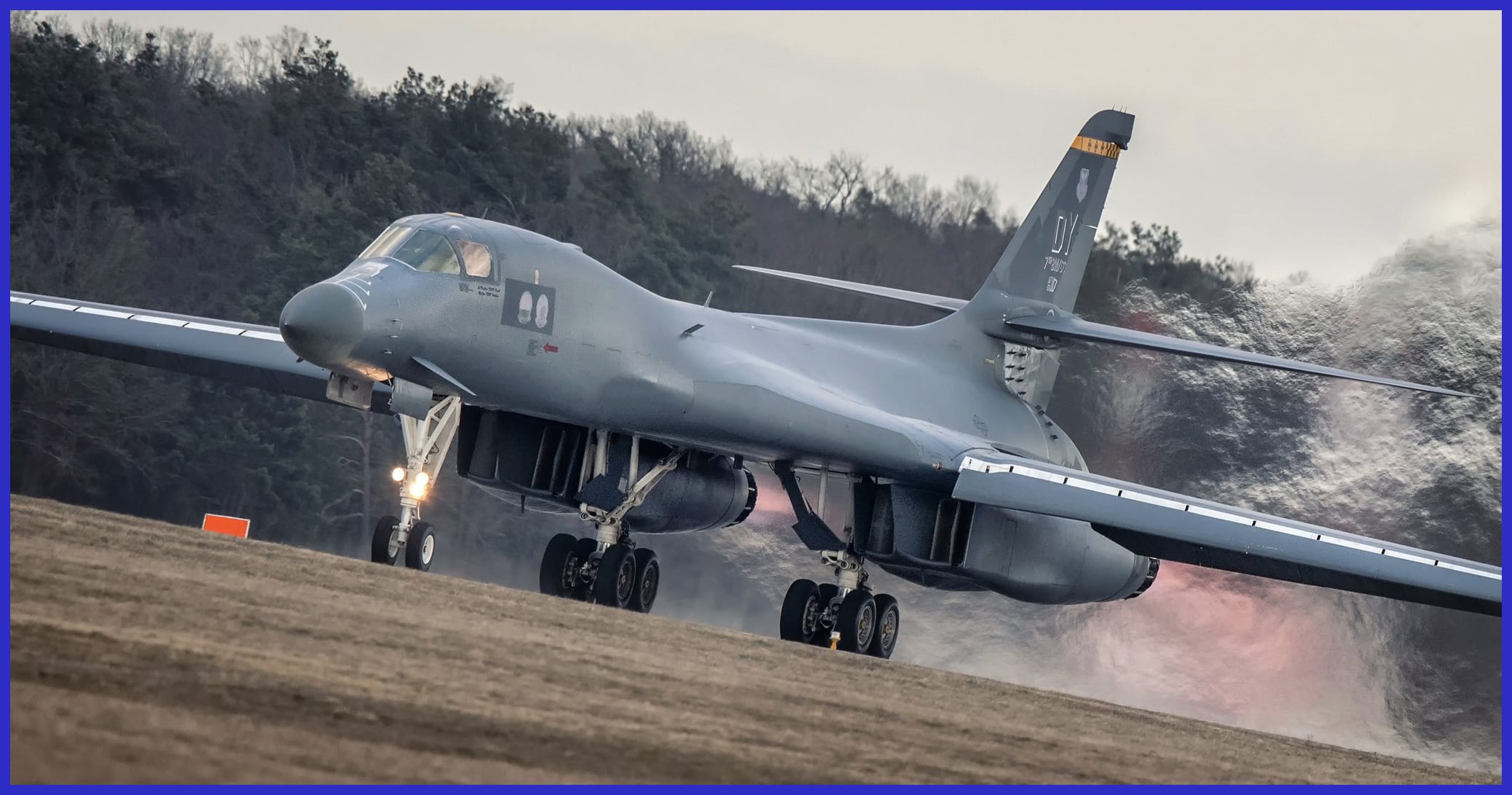
Conventional Mission Upgrade Program (CMUP): CMUP focused on enhancing the B-1B’s capability to carry and deploy a wide range of precision-guided munitions (PGMs), including Joint Direct Attack Munitions (JDAMs) and Small Diameter Bombs (SDBs). The Block D standard introduced a “Near Precision Capability” through improved weapons and targeting systems, along with the addition of advanced secure communications capabilities. The initial phase of the electronic countermeasures upgrade incorporated the Joint Direct Attack Munition (JDAM), the ALE-50 towed decoy system, and anti-jam radios. This upgrade enabled the B-1B to engage multiple targets with greater accuracy and reduced collateral damage.
Wind-Corrected Munitions Dispenser (WCMD): The WCMD upgrade improved the B-1B’s precision in delivering ASM units and other munitions by accounting for wind and atmospheric conditions during deployment. Block E standard included avionics computer enhancements and the addition of Wind Corrected Munitions Dispenser (WCMD), AGM-154 Joint Standoff Weapon (JSOW), and AGM-158 JASSM (Joint Air to Surface Standoff Munition). These upgrades significantly enhanced the bomber’s capability and were finished by September 2006.
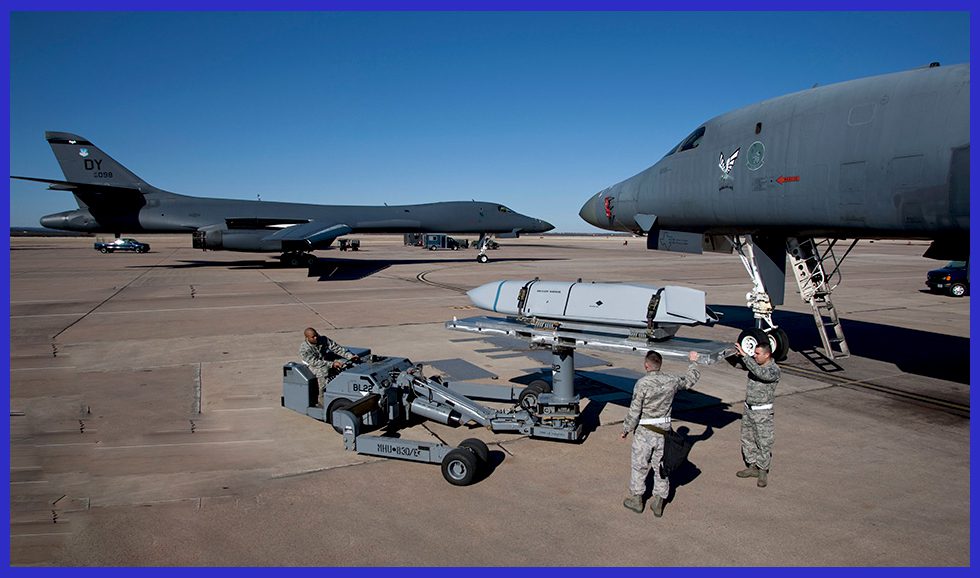
The Sniper XR targeting pod System: The incorporation of the Sniper XR targeting pod system enhanced the B-1B’s capability to identify and monitor adversary aircraft and potential threats, reducing dependency on radar systems alone. This advancement significantly improved overall situational awareness and the aircraft’s survivability. The integration of the Sniper XR targeting pod onto the B-1 fleet took place in 2007. The pod is affixed to an external hardpoint situated on the aircraft’s chin in close proximity to the forward bomb bay. Following an expedited testing phase, the Sniper pod was deployed in the summer of 2008. Notably, upcoming enhancements in precision munitions encompass the integration of the Small Diameter Bomb (SDB) has also been added.
Link 16 Data Link Integration: The integration of Link 16 data link technology improved the B-1B’s ability to share real-time information with other NATO aircraft, ground forces, and command centres, enhancing coordination and collaboration in joint operations.
The fleet of B-1B aircraft has been undergoing a series of upgrades aimed at addressing technical challenges and enhancing operational readiness. There is also potential for the bomber to integrate the Hypersonic Air-breathing Weapon Concept (HAWC) in the future. These cumulative upgrades and advancements have effectively enabled the B-1B Lancer to maintain its significance and efficacy within contemporary warfare contexts, ensuring its continuous and essential contribution to the strategic and tactical operations of the United States Air Force. However, discussions regarding potential retirement and the transition to the next-generation B-21 Raider stealth bomber are currently underway in rapid development.
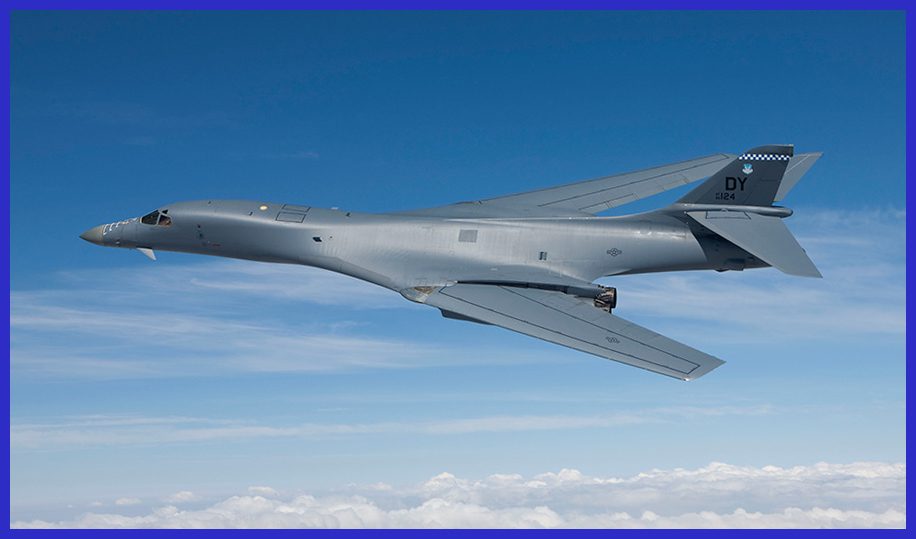
The Updated Rockwell/Boeing B-1 Lancer: Technical Specifications (2023)
- Country Of Origin: USA
- Crew: 4 ( aircraft commander, copilot, and two weapon systems officers )
- Length: 146 ft ( 44.5 m )
- Wingspan: 137 ft ( 41.8 m )
- Swept wingspan: 79 ft ( 24.1 m ) swept
- Height: 34 ft ( 10.4 m )
- Wing area: 1,950 sq ft ( 181 m2 )
- Empty Weight: 87,090 kg ( 1,92,000 lb )
- Gross weight: 1,47,871 kg ( 3,26,000 lb )
- Max Takeoff Weight: 2,16,364 kg ( 4,77,000 lb )
- Fuel capacity: 1,20,326 kg ( 2,65,273 lb )
- Powerplant: 4 × General Electric F101-GE-102 afterburning turbofan engines, 17,390 lbf ( 77.4 kN ) thrust each dry, 30,780 lbf ( 136.9 kN ) with afterburner
- Max Speed: Mach 1.25
- Regular range: Intercontinental, 9,400 km ( 5,840 mi ) with weapon load of 16,800 kg ( 37,000 lb ). Max range is 12,000 km ( 7,456 mi ) without weapons.
- Fast action combat range: 5,543 km ( 3,444 mi ) with a full internal weapons load of 34,019 kg ( 74,999 lb )
- Service ceiling: 60,000 ft ( 18,000 m )
- Rate of climb: 28.84 m/s
- Armament: The aircraft features three internal bomb bays designed to hold 75,000 lb (34,000 kg) of ordnance, with the capability to carry various combinations of general-purpose (GP) bombs, naval mines, Cluster Bomb Units (CBU), JDAM GPS-guided bombs, JSOW, LRASM, JASSM, B61, and B83 nuclear bombs.
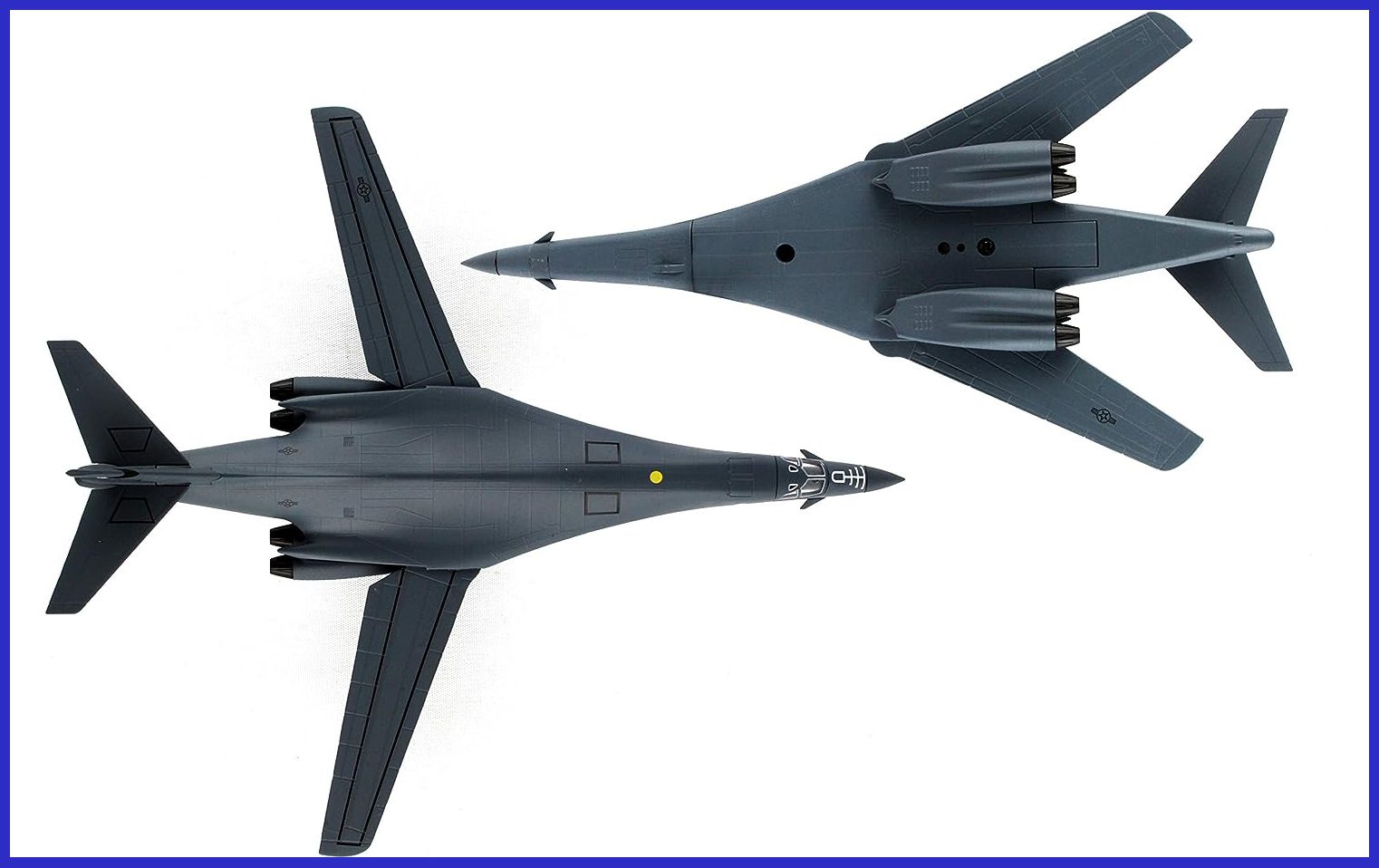
Don’t miss out on this exclusive chance to acquire premium models of the iconic B-1 Lancer, known for its advanced bomber reputation and impeccable zero-loss track record. Available for purchase on Amazon, these meticulously crafted models perfectly capture aviation history’s essence. Click here to secure yours before limited stock runs out.
In conclusion, the B-1 Lancer Bomber stands as an enduring testament to aerospace engineering and strategic innovation. From its inception during the Cold War to its pivotal role in modern conflicts, the B-1 has showcased adaptability and potency. Its iconic variable-sweep wing design, powerful engines, and advanced avionics embody the fusion of speed, range, and precision. Throughout its operational history, the B-1 excelled in conventional warfare, delivering a diverse payload with unwavering accuracy.
Evolving with the times, it seamlessly transitioned from Cold War tensions to counterterrorism efforts, including neutralizing ISIS hideouts, thus exhibiting its timeless relevance and strategic significance. As discussions about its future unfold, the B-1’s legacy as a formidable bomber continues—an aircraft that transcends eras and remains an integral part of the United States Air Force’s aerial might until its role is entirely assumed by the B-21 Raider.

Important Announcement for Our Valued Readers!
After an article is published, it is possible that updates or changes may have occurred beyond the time of publication. Therefore, it is important to be aware that certain information in the article might be outdated. To ensure the most accurate analysis, it is highly recommended to verify the content with the latest sources available.
However, we are dedicated to delivering outstanding articles on military products and global updates. Maintaining quality and smooth operation requires resources. Your support sustains our efforts in providing insightful content. By purchasing high-quality products through our affiliated links, you help us keep our platform alive and acquire top-notch items. Your unwavering support is invaluable and inspires us to strive further.
We welcome your suggestions and requests for more information, as we value feedback from our readers. If there’s specific defence material or equipment not covered on our site, please share your request in the comments. We’ll strive to research and provide the required information. We sincerely thank you for your unwavering interest in our website, and we eagerly anticipate hearing from you! Enjoy your reading experience!
